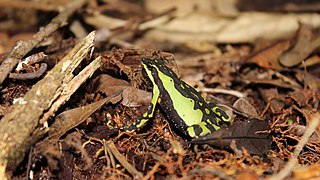
Atelopus balios, the Rio Pescado stubfoot toad, is a species of toad in the family Bufonidae. It is endemic to southwestern Ecuador, with records from Pacific lowlands in Azuay, Cañar, and Guayas Provinces. It is a rare species that was already suspected to be extinct, but a single specimen was discovered in 2011 by a team from Conservation International during a hunt for missing amphibians. The decline in amphibian populations is well documented. The Atelopus balios is Critically Endangered as a result of the widespread amphibian Chytridiomycosis fungus that has decimated other amphibian populations. There are only 10 known findings of the tadpole, Atelopus balios.
The Venezuelan yellow frog is a species of toad in the family Bufonidae endemic to Venezuela. Its natural habitats are subtropical or tropical moist montane forests, rivers, and intermittent rivers, and is threatened by habitat loss. It is known locally as sapito arlequin de la carbonera.

Atelopus certus, the Darien stubfoot toad or Toad Mountain harlequin frog, is a species of toad in the family Bufonidae endemic to Panama.

Atelopus chiriquiensis, the Chiriqui harlequin frog or Lewis' stubfoot toad, is an extinct species of toad in the family Bufonidae that was found in the Cordillera de Talamanca in Costa Rica and western Panama. Its natural habitats were stream margins in lower montane wet forests and rainforests. Its elevational range was 1,400–2,500 m (4,600–8,200 ft) asl.

The elegant stubfoot toad or Pacific jambato frog is a species of toad in the family Bufonidae found in lowlands and Andean slopes of northwest Ecuador to 1,140 m (3,740 ft) asl and on the Gorgona Island, off southwest coast of Colombia. It was described by George Albert Boulenger in 1882 based on a specimen collected by Edward Whymper. It is known in Spanish as rana jambato del Pacífico or simply jambato del Pacífico.
Atelopus famelicus is a species of toad in the family Bufonidae endemic to Colombia. Its natural habitats are subtropical or tropical moist montane forests and rivers. It is threatened by habitat loss.
The Guanujo stubfoot toad, known in Spanish as puca sapo, is a species of toads in the family Bufonidae endemic to Ecuador. Its natural habitats are subtropical or tropical moist montane forests and rivers. It is threatened by habitat loss.
Atelopus halihelos, the Morona-Santiago stubfoot toad, is a species of toad in the family Bufonidae endemic to Ecuador. Its natural habitats are subtropical or tropical moist montane forests and rivers. It is threatened by habitat loss.
Atelopus longibrachius, the El Tambo stubfoot toad, is a species of toad in the family Bufonidae. It is endemic to Colombia and known from the region of its type locality, El Tambo, Cauca, as well as from Chocó, both on the western flanks of Cordillera Occidental. Its natural habitats are tropical moist lowland forests where it lives on the ground. Breeding is assumed to take place in streams. It is potentially threatened by chytridiomycosis and habitat loss.
Atelopus lynchi is a species of toad in the family Bufonidae. It is endemic to Ecuador. Its natural habitats are subtropical or tropical moist lowland forests, subtropical or tropical moist montane forests, and rivers. It is threatened by habitat loss.
Atelopus muisca is an extinct species of toad in the family Bufonidae. It is endemic to Colombia. Its natural habitats were subtropical or tropical moist montane forests, subtropical or tropical high-altitude grassland, and rivers. It is threatened by habitat loss.

Atelopus nanay is a species of toads in the family Bufonidae.
Atelopus oxyrhynchus is a species of toad in the family Bufonidae. It is endemic to Venezuela. Its natural habitats are subtropical or tropical moist montane forests, rivers, and intermittent rivers. It is threatened by habitat loss.

Atelopus palmatus is a species of toad in the family Bufonidae. It is endemic to the Cordillera Oriental of eastern Ecuador and is known from the Napo and Pastaza Provinces at elevations of 1,150–1,740 m (3,770–5,710 ft) above sea level. Its type locality is "Rio Pastaza".
Atelopus peruensis is a species of toad in the family Bufonidae. It is endemic to Peru. Its natural habitats are subtropical or tropical high-altitude grassland and rivers.
The green and red venter harlequin toad or sapito arlequin de Pinango is a species of toad in the family Bufonidae. It is endemic to Venezuela. Its natural habitats are subtropical or tropical moist montane forests, rivers, and intermittent rivers. It is threatened by habitat loss.

Atelopus pulcher is a species of toad in the family Bufonidae. It is endemic to eastern Peru where it is found in the Huallaga River drainage; its range might extend to Ecuador. Its natural habitats are lowland and premontane tropical forests. It is a diurnal and terrestrial species that breeds in streams.
Atelopus reticulatus is a species of toads in the family Bufonidae.
Atelopus seminiferus is a species of toad in the family Bufonidae. It is endemic to Peru. Its natural habitats are subtropical or tropical moist montane forests and rivers.
Atelopus simulatus is a species of toad in the family Bufonidae. It is endemic to Colombia. Its natural habitats are subtropical or tropical moist montane forests and rivers. It is threatened by habitat loss.







